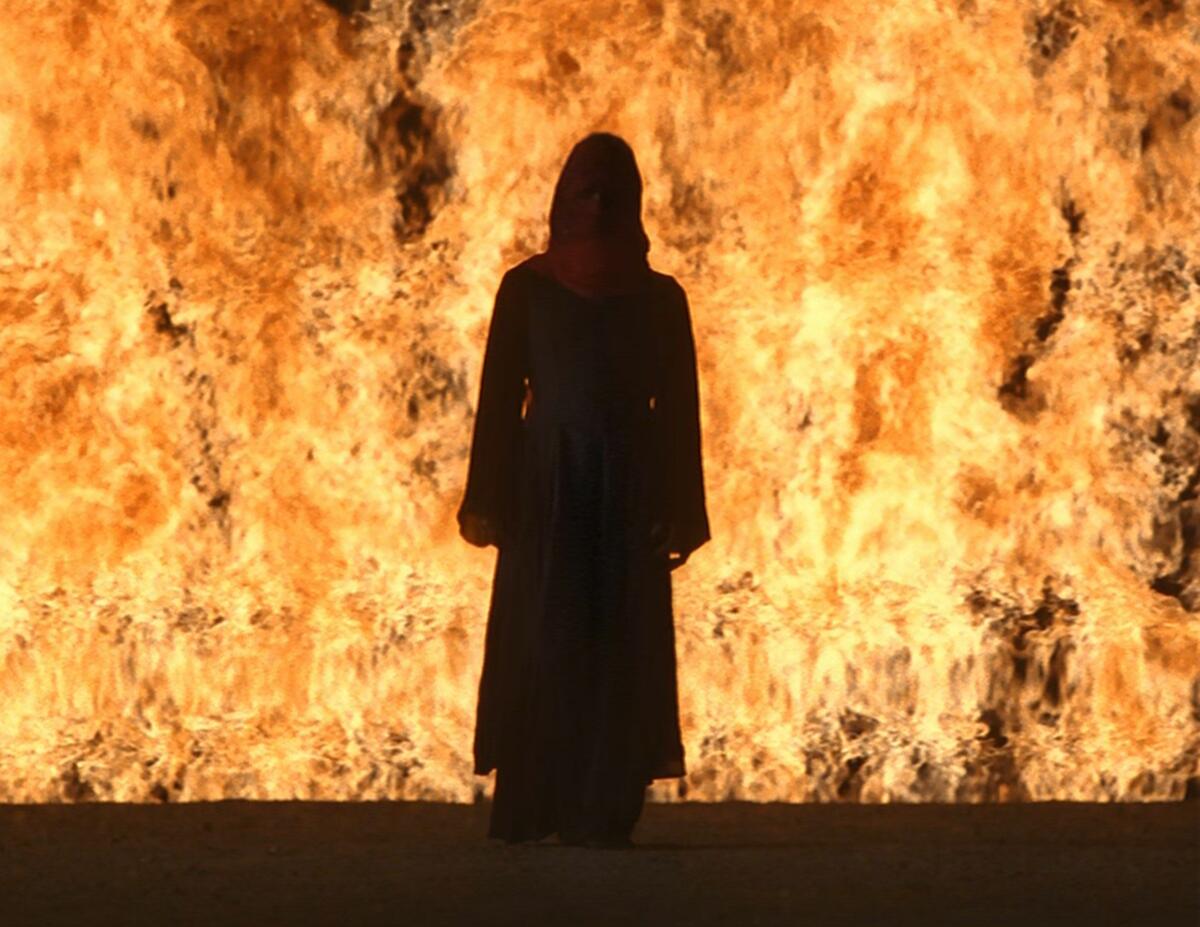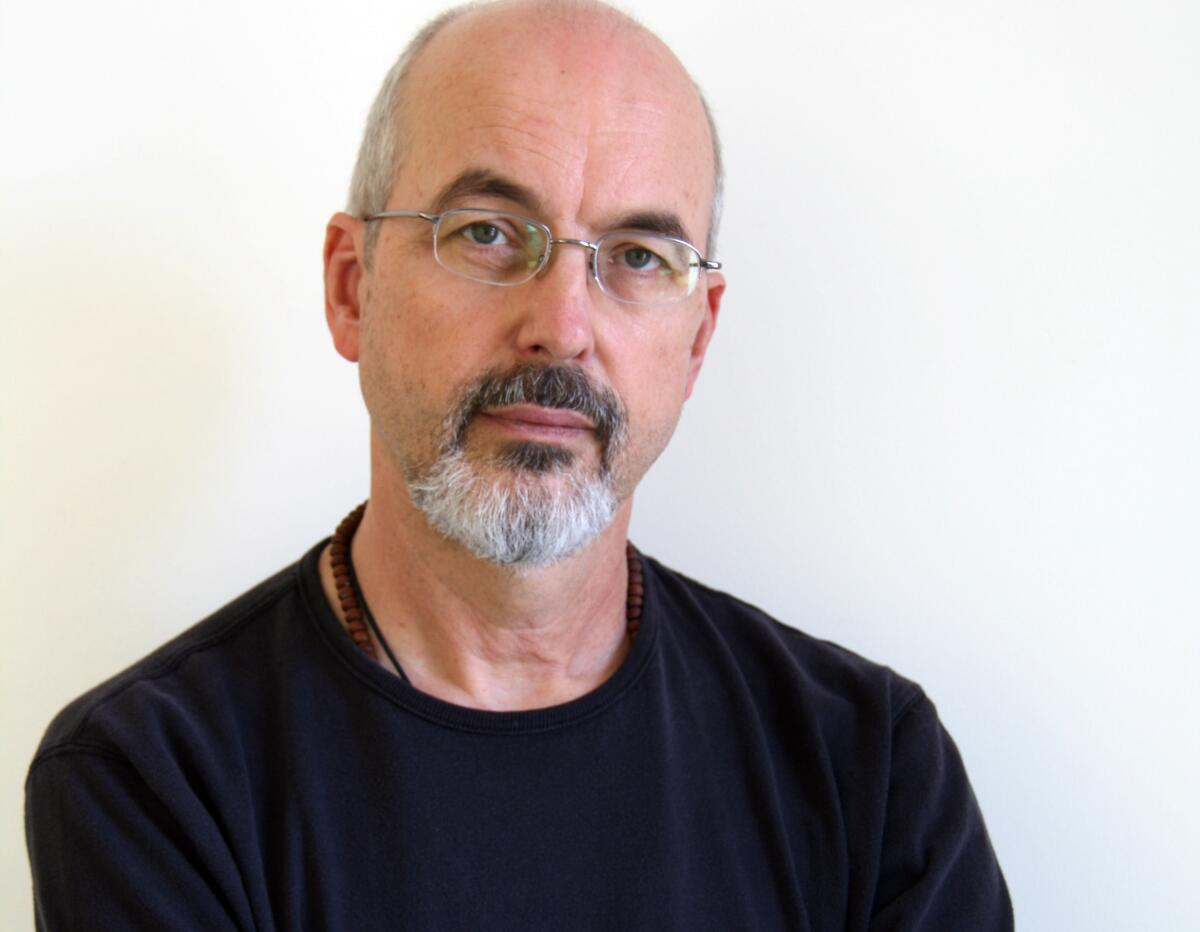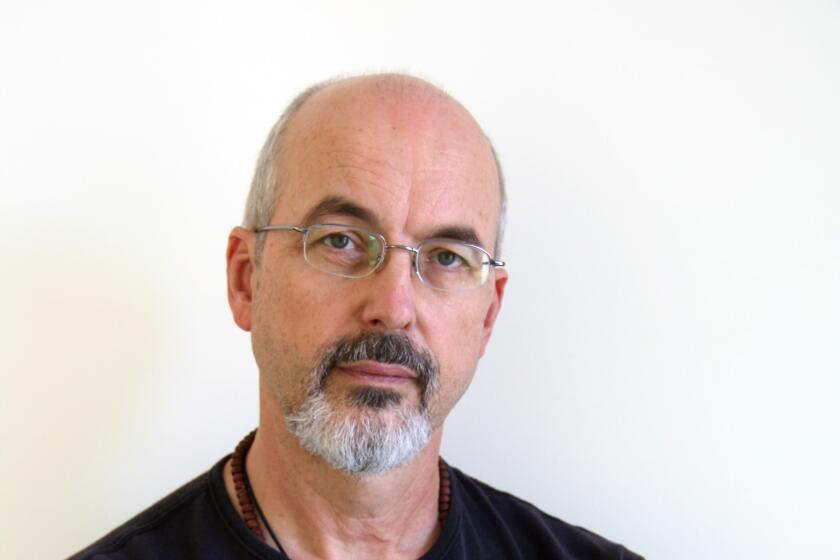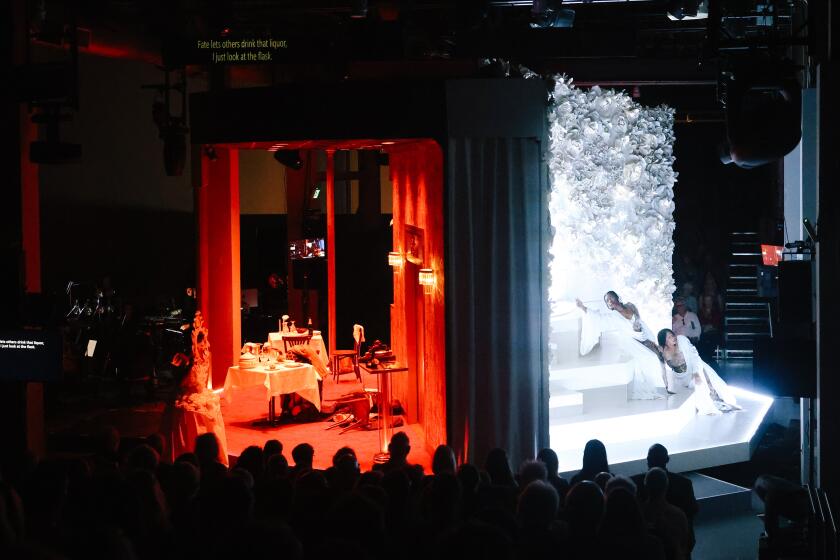Commentary: Bill Viola was our greatest video artist, but he couldn’t have done it without sound

- Share via
On a stormy, steamy summer day in 2003, as I approached the Gasometer Oberhausen, which the Third Reich used for fuel storage, I expected the enormous cylindrical structure would prove the gloomiest building in Germany. I entered only because Bill Viola’s epic “Five Angels for the Millennium” was projected on five astonishing screens installed as high as 200 feet.
Thanks to their size and the sheer beauty of the underwater photography and lighting, the “angels,” filmed in a pool in Long Beach, were overwhelming — but not quite overwhelming enough to make the smelly gasometer godly. It took Viola’s atmospheric soundscape of indeterminate voices and noises to make them miraculous. The reverberation gave the giant angels life by creating a vast, limitless, sense of space. Suddenly, I could breathe again. The awful gasometer transformed into the most glorious of cathedrals.
Viola, who died Friday in Long Beach at age 73, may have been a video artist, but he was first a sound artist and remained an incomparable one. His greatness was not necessarily the way he used sound or even the sound itself, rather why he used sound, where he used sound and how he interacted with sound. I suspect on some level, perhaps unconsciously, music also drove his video creation. And that creation has had a lasting effect on music.

Viola’s career began in the early 1970s when he assisted Nam June Paik, who created video art as we know it. Paik happened to be a Korean music historian focused on studying Schoenberg until he encountered John Cage in Germany in 1957 and joined the Cage-influenced anarchic Fluxus movement, which then led to video.
Next, Viola assisted pianist and electronic music composer David Tudor, the most accomplished pianist of the post-World War II avant-garde and Cage’s closest collaborator in the 1950s. By the time Viola worked with Tudor, the pianist had turned to composition by employing electronic sounds meant to mimic the working of our nervous system. I mentioned to Viola that no matter how many times Tudor sort of explained to me what he was up to, I had no idea what he was talking about. “Nobody did,” Viola replied. And that, in part, is what made the strange sounds so compelling.
In his own work, Viola followed Cage’s and Tudor’s paths of not looking for answers, and that allowed him to pursue life’s mysteries. He studied spiritual practice, particularly Buddhism but also Christian and Islamic mysticism. He found ways of presenting human bodies in his videos that were utterly lifelike but in a kind of suspended state of neither here nor there.
They could be ascending or descending or in barely perceptible motion. You look and you look and you look. Looking becomes meditation. Eventually, you realize that you are looking for what you can’t see. It is the spirit that you sense. To make that happen, Viola needed faith in indeterminacy, which is at the heart of what made Tudor so fascinating.
But Viola proved a compelling composer in his own right, as well. “The Talking Drum” — his piece for bass drum, temple gong, prerecorded sound and electronic and performed in a dry pool — explores the sonic implications of a heartbeat with thrilling result.
Sound, though, is perhaps video’s greatest obstacle. Exhibitions at museums and galleries exist for seeing not listening. For me, Viola’s most memorable achievement came the year after Oberhausen at Walt Disney Concert Hall with “The Tristan Project” in 2004. It was an enormous undertaking, a performance of Wagner’s opera “Tristan und Isolde” at the then-new Frank Gehry hall, with the Los Angeles Philharmonic conducted by Esa-Pekka Salonen, staging by Peter Sellars and video by Viola on a massive, newly developed, high-definition screen.
Artist Bill Viola, whose pioneering work with video since the 1970s opened the door to what would become a major artform internationally, has died. He was 73.
Viola’s imagery showed acts of purification through fire and water and air that neither followed the score nor projected the narrative. Once again, Viola was after the spirit, the unspoken and unknown. The human drama occurred onstage. Wagner’s score revealed the sense-filling enormity of emotions. Operating in a parallel universe, video here readied the soul for the transcendence Wagner would offer. In the 139 years of productions of the most influential opera in history, no one had ever done this.
It didn’t happen by Viola alone, or in a void. By 2004, Viola had become a quintessential L.A. artist. Living in Long Beach, he found collaborators in Sellars, who curated Viola exhibitions and who brought the artist to Salonen’s attention.
In 1999, Sellars curated an L.A. Phil concert at the Hollywood Bowl that included Salonen conducting Edgard Varèse’s “Déserts,” with video by Viola. Scenes of shimmering desert and fire might not go over so well in our changing climate, but Viola’s space-transforming power and a live “Deserts” soundtrack put us there.
Although “The Tristan Project” went on to be a gripping, fully staged production at Paris Opera and elsewhere, and the semi-staged concert version at Disney has been performed in other halls, the effect in Gehry’s space, where it has twice returned, cannot be copied. This became the “Tristan,” time-stopping for our time and place. No opera production compares.
Yuval Sharon’s ‘The Comet / Poppea’ is as an experimental dialogue with history in a way that only opera, with its capacity to worm its way inside the minds of characters, might attempt.
The monumental video was filmed on a soundstage and required a 30-member crew for the special effects of water and fire. I attended one afternoon of filming. There was a lot of activity and confusion. Viola was vague, giving few instructions. That was left to his wife and crucial collaborator, Kira Perov, who made pretty much everything Viola did possible.
For the record:
5:13 p.m. July 16, 2024An earlier version of this article misspelled the last name of Bill Viola’s wife, Kira Perov, as Petrov.
Watching Viola, I got the distinct impression that he was not so much looking as listening, lost in his own imagination, seeking the unseen by taking in the environment. I asked him if that were true. “Yes,” he replied, distractedly, looking at neither me nor the stage but toward Perov.
Suddenly, there was a big splashing sound on the stage. Someone shouted, “Did you see that?”
Viola turned to me and excitedly asked, “Did you hear that?” and went to look for his wife.
More to Read
The biggest entertainment stories
Get our big stories about Hollywood, film, television, music, arts, culture and more right in your inbox as soon as they publish.
You may occasionally receive promotional content from the Los Angeles Times.












